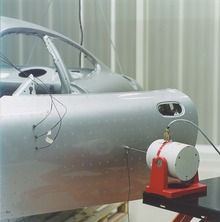

Modal analysis is the study of the dynamic properties of systems in the frequency domain. It consists of mechanically exciting a studied component in such a way to target the modeshapes of the structure, and recording the vibration data with a network of sensors. Examples would include measuring the vibration of a car's body when it is attached to a shaker, or the noise pattern in a room when excited by a loudspeaker.
Modern day experimental modal analysis systems are composed of 1) sensors such as transducers (typically accelerometers, load cells), or non contact via a Laser vibrometer, or stereophotogrammetric cameras 2) data acquisition system and an analog-to-digital converter front end (to digitize analog instrumentation signals) and 3) host PC (personal computer) to view the data and analyze it.
Classically this was done with a SIMO (single-input, multiple-output) approach, that is, one excitation point, and then the response is measured at many other points. In the past a hammer survey, using a fixed accelerometer and a roving hammer as excitation, gave a MISO (multiple-input, single-output) analysis, which is mathematically identical to SIMO, due to the principle of reciprocity. In recent years MIMO (multi-input, multiple-output) have become more practical, where partial coherence analysis identifies which part of the response comes from which excitation source. Using multiple shakers leads to a uniform distribution of the energy over the entire structure and a better coherence in the measurement. A single shaker may not effectively excite all the modes of a structure.[1]
Typical excitation signals can be classed as impulse, broadband, swept sine, chirp, and possibly others. Each has its own advantages and disadvantages.
The analysis of the signals typically relies on Fourier analysis. The resulting transfer function will show one or more resonances, whose characteristic mass, frequency and damping ratio can be estimated from the measurements.
The animated display of the mode shape is very useful to NVH (noise, vibration, and harshness) engineers.
The results can also be used to correlate with finite element analysis normal mode solutions.